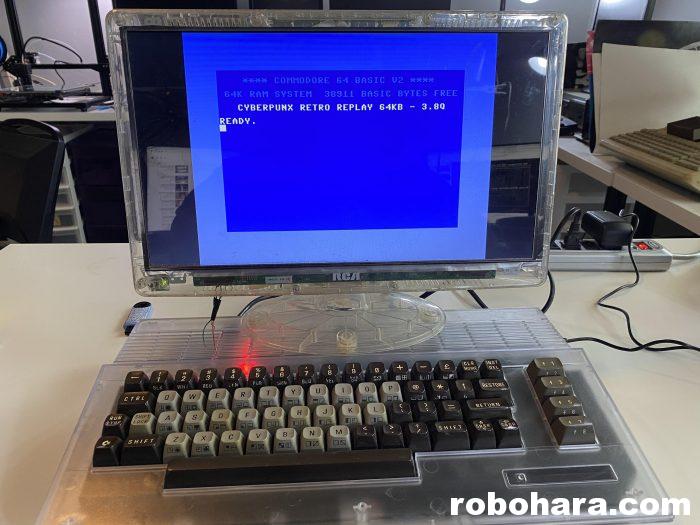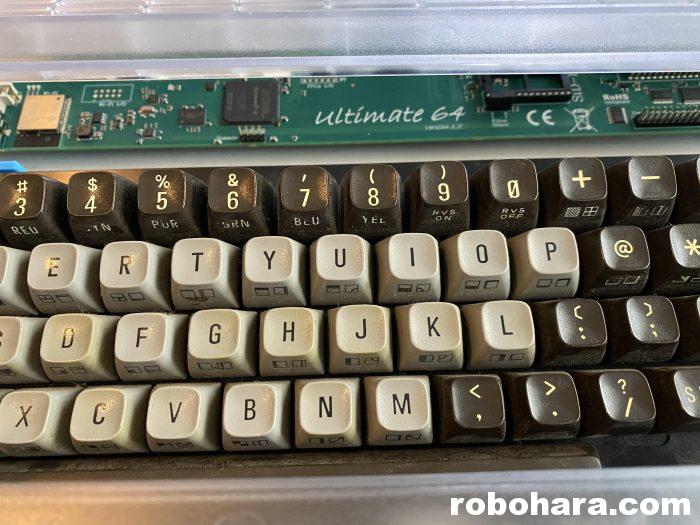
After an extroidinarily long period of procrastination, I got my Ultimate 64 up and running over the weekend.
The Ultimate 64 is a drop-in motherboard replacement for the original Commodore 64. Not only does it retain most of the original’s ports (joystick, cartridge, video, and serial) but it adds USB, ethernet, and HDMI output to a nearly 40-year-old computer. The USB ports allow modern joysticks to be used and games to be loaded directly from a USB stick, eliminating the need for a physical disk drive. The ethernet port can be used to connect to BBSes hosted on the internet, or control the device. The addition of HDMI obviously allows the computer to to be connected to modern monitors.
The Ultimate 64 only comes with a motherboard; owners have to provide their own “donor system” to house the device. Several years ago I purchased a bunch of Commodore 64 cases through Kickstarter (including this clear one) which I used, but I still needed the actual keys. In the late 80s, I built a custom Commodore 64 keyboard by mixing and matching brown C64 keys with gray ones from a C16 replacement keyboard I found at Radio Shack. I don’t remember why I disassembled that machine (maybe it died) but I’ve had the keyboard stored away in a box “just in case I need it” since sometime around 1990. 30 years later, I finally needed it. (It ain’t hoarding if it’s useful!) It feels a little weird to type on the same keys I used 35 years ago.
To match the clear case, I pulled out a clear monitor I’ve been saving for just this occasion. I own two clear computer monitors, purchased at separate garage sales. If you’ve never seen or heard of a clear television before, you’re probably a good person. Clear televisions are most commonly found in prisons; the clear plastic makes it difficult for prisoners to hide contraband inside them. I have two, one CRT and one flat screen, and if you were to purchase one new they are unreasonably expensive compared to traditional monitors. The flat screen one I’m using is a 15″ model that sells on Amazon for $150 (you couldn’t give away a traditional old 15″ flat screen monitor). It’s part of the prison racket; prisoners are forced to buy these see-through electronics through the prison system at an exorbitant markup (which traditionally means their families pay for them). Once they leave prison they can take the electronics with them, but if they ever return, they cannot take them back inside and must purchase new electronics. Typically once purchased they tend to stay inside the prison system, which is why it’s so rare to run across them on the outside. I’ve only run across two of them for sale in my entire life, and I own them both.
My Ultimate 64 build isn’t finished. The main problem I’m having is the keyboard’s keys are stiff and partially non-responsive. A friend of mine is shipping me his dead Commodore 64 so that I can salvage the keyboard from it. In the meantime I was planning to disassemble this one and give it a thorough cleaning, but I ran out of weekend before I ran out of projects. Maybe one day this week after work I’ll find some time.
There are dozens of ways to enjoy the Commodore 64 today, from inexpensive models such as the Commodore 64 Mini and TheC64, to homebrew applications like BMC64 (a Commodore system that runs on a Raspberry Pi) to expensive FPGA implementations like the MiSTer and the Ultimate 64. The flooded market is the opposite of a problem; there are solutions for every price point, and the number of solutions points to both how popular the Commodore 64 was, and how active its fan base is to this day.

Sir! This is your lucky day! LOL.
I’d be willing to trade you the item pictured for that C64! (maybe throw in some cash also).
https://u.pcloud.link/publink/show?code=XZ37ipXZe1TTN4fKwVkrD4EQ3j4ijhOLps6k
I should have clarified! That’s not the original crappy asteroids, that’s now a 60 in 1 jamma.
Jimmy
I really like that idea of a two-toned keyboard for the C64. It’s a very nice touch.
I’m just curious why you know so much about electronics in prison.